Video conference notes 6 February 2014 - Raptors
SWIFFT video conference notes are a summary of the video conference and not intended to be a definitive record of presentations made and issues discussed.
This video conference was supported through resources and technology provided by the Department of Environment and Primary Industries, Victoria.
The first video conference for 2014 had a theme on Raptors.
A total of 95 participants were connected across 14 locations; Ararat, Ballarat, Bendigo, Benalla, Colac, Federation University, Geelong, Hamilton, Heidelberg (Arthur Rylah Institute), Heywood, Horsham, Melbourne (Nicholson Street), Traralgon and Warrnambool.
Preliminary list of groups/organisations in attendance;
- Educational: Federation University.
- Local Government: City of Greater Geelong, Nillumbik Shire, Moorabool Shire.
- Field Naturalist Clubs: Ballarat, Geelong, Hamilton, Portland.
- Community Conservation Groups: Friends of Eastern Otways, ANGAIR, Geelong Environment Council, Ballarat Birdlife, Torquay Landcare, Bellarine Landcare. Windamara Aboriginal Corp., Upper Mt Emu Ck. Landcare, Garibaldi Landcare, Basalt to Bay Landcare.
- Conservation Organisations: Parks Victoria, Dept. of Environment and Primary Industries staff across 13 locations, inc. Nicholson Street Melbourne and Arthur Rylah Institute, Heidelberg.
- Industry: Ecology & Heritage Partners, Brett lane & Associates.
SPEAKER SUMMARIES
Peregrine Falcon Research - Victor Hurley, Deprtment of Environment and Primary Industries, Victoria. Presentation postponed due to Mallee fires.
Breeding success of the White-Breasted Sea Eagle on the Gippsland Lakes - Faye Bedford Presentation postponed due to Gippsland fires.
Plains Grassy Raptors - Rehabilitation at Hawk Haven
Martin Scuffins, Hawk Haven
Motor vehicle impactMartin introduced his talk by pointing out that most of the birds of prey brought to him at Hawk Haven are injured as a result of human related causes, through our technology and our way of life. Urbanisation, habitat destruction, traffic, powerlines and barbed wire fences and conflict with human activities can all impact on raptors in one way or another.
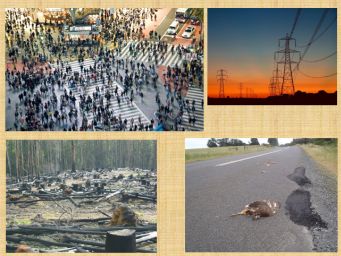 |
| Our way of life can impact on raptors |
This is a frequent cause of injury or mortality to birds of prey as they are hit by vehicles whilst feeding on road kill such as rabbits. The ability of birds to take off and avoid collision is often impaired due to extra weight from feeding.
Barbed wire fences
Martin estimates that about 8% of injured birds brought to him from the public are injuries caused by collision with barbed wire. Martin said that many of the injuries are of a nature that renders the bird incapable of rehabilitation and must be put down.
Powerlines
Fast flying birds of prey such as the Peregrine Falcon can reach speeds of 232 km/hr in a dive and can sustain fatal wing injures if a power line is hit. Even slower moving species such as the Wedge-tailed Eagle can be injured by colliding with powerlines.
A common injury from powerlines is a broken humorous wing bone. Depending on where the break occurs determines the likelihood of successful treatment or not. Breaks occurring in the middle of the bone being easier to pin whereas breaks near the joint are very difficult to treat.
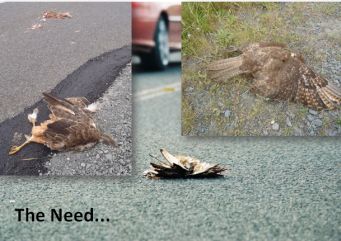 | 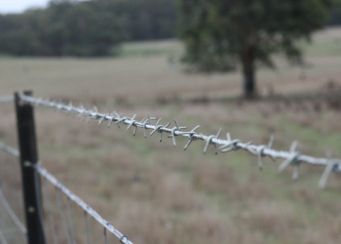 | ||
| Raptors feeding on road kill can become road kill themselves | About 8% of birds dealt with by Martin are through collission with barbed wire | ||
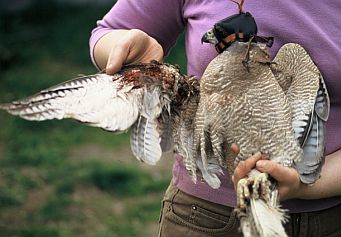 | 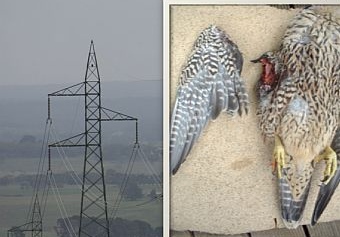 | ||
| Fatal barbed wire injury to female Brown Goshawk | Juvenile male Peregrine Falcon with fatal wing injury from collision with powerline. |
Human persecution
Birds of prey can come into conflict with humans, particularly in situations where domestic poultry, pigeons, aviary birds etc. are kept. Goshawks are notoriously brazen hunters and are sometimes captured, injured or even killed by people who see them as a threat.
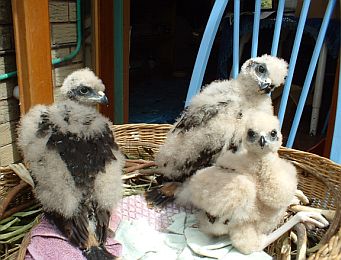 | |
| Swamp Harrier chicks rescued from a nest in a cropping paddock. | |
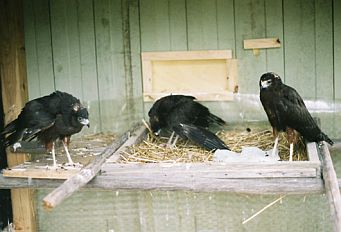 | |
| Swamp Harriers hack pen which allows for flight in and out of the pen. |
There are occasions when Wedge-tailed Eagles can be a problem to sheep farmers raising lambs. These encounters are rare and usually involve birds which have either not fully developed hunting skills such as juvenile birds or old birds incapable of hunting.
People sometimes pick up pre-fledgling birds of prey that have left the nest before they can fly. In most cases these birds are best left to fend for themselves with their parent birds. Only where there is imminent danger should juvenile birds be rescued and taken to a registered Wildlife Shelter where they can be raised in captivity for eventual release into the wild.
Rehabilitating birds of prey
Martin said Wedge-tailed Eagles are very difficult to treat and rehabilitate due to their size and difficulty in reacclimatising to flight and hunt in the wild. Wedge-tailed Eagles are highly territorial with some areas occupied by juvenile birds whilst other areas have established pairs. Releasing a rehabilitated Wedge-tailed Eagle into the wild can place the bird in conflict with already occupied habitat, thus reducing its chances of survival.
Preventing conflicts with birds of prey
Martin stressed the complexity of raising birds of prey in captivity, including nutritional requirements, avoiding human imprinting and acclimatising the birds to fly and fend for themselves in the wild.
Martin emphasised the need to ensure habitat for birds of prey is protected because no amount of captive rehabilitation can prepare a bird for release if it has no suitable habitat to be released into.
Martin spoke about simple methods for reducing bird of prey conflicts with caged birds and poultry. Shade cloth or nylon bird netting can be used to cover chicken runs. Shade cloth is particularly good as it obscures line of sight. Birds of prey held captive or trapped in wire mesh cages quickly deteriorate as their flight feathers become damaged by the wire mesh. Birds with damaged feathers have difficultly flying and hunting and require long periods rehabilitation before being released in a condition where they can survive in the wild.
Restoring biodiversity through habitat restoration
Martin spoke about his 20 acre property which he has had since 1999 and the properties transformation into a valuable area for biodiversity through natural regeneration, protection of native grasslands and habitat enhancements including an ephemeral wetland. As new habitats have established he has observed an increase in native birds, fish, mammals and amphibians with several threatened species being present.
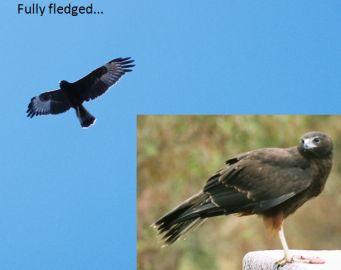 |
| Releasing a bird back into the wild is a special moment |
Key points from questions
- Wind farms can cause injuries to raptors but Martin was unsure of the scale of the problem in Victoria. He has received three Wedge-tailed Eagles and one Brown Falcon with injuries caused by wind farms but felt the scale of the problem in the Ballarat area is low compared with other causes of injury.
- Banding birds of prey prior to release adds an additional level of complexity for shelter operators and is not something which is done on a regular basis.
- Domestic stray cats which interfere with wildlife need to be captured and taken direct to the local council.
- Swamp Harriers sometimes nest in crops and their nests can unknowingly be destroyed by harvesters.
- Martin has found that raptor chicks need a certain amount of natural sunlight for vitamin D which also assists in the uptake of Calcium.
- Removing road kill from a road can prevent a raptor from being hit whilst feeding.
Contact: Martin Scuffins, Hawk Haven (03) 53414623,
Using substitute prey to manage problem Wedge-tailed Eagles
Stan Williams, Senior Wildlife Officer, Department of Environment and Primary Industries, Victoria
Stan spoke about his experiences with Wedge-tailed Eagles dating back over many years and his knowledge concerning the illegal trapping or killing of problem Wedge-tailed Eagles which have been feeding on lambs. In his capacity as a Wildlife Officer he spoke about several dealings with sheep farmers who have been impacted upon by Wedge-tailed Eagles feeding on lambs. He discussed methods which he has used to resolve attacks without having to harm the eagles.
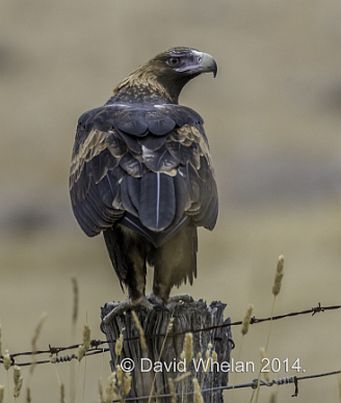 |
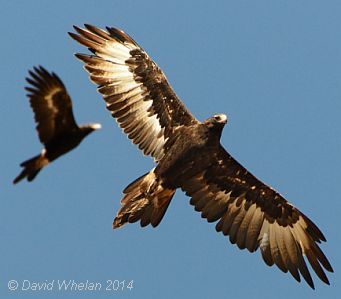 |
| Wedge-tailed Eagle images: David Whelan |
Stan has worked with farmers to overcome issues with problem eagles by introducing substitute prey. Initially he used various items of road kill, mainly kangaroos or wallabies which an eagle could feed on. The use of substitute prey was expanded to include an 'Authority to Kill Wildlife' so that a farmer could shoot a limited number of Kangaroos to provide a substitute source of food during the lambing season. This method worked to a limed extend but was replaced by a program of using rabbits shot on a property as substitute prey. The use of rabbits has been used with success and has proven an effective means of alleviating the problem .
The issue of Wedge-tailed Eagles feeding on lambs appears to be an uncommon event which can be dealt with on a case by case basis. The issue is usually associated with either young eagles which have not yet fully developed hunting skills or old eagles which are less efficient hunters. The role of other predators such as foxes which are far more commonly associated with lamb predation must also be taken into account.
Key points from questions
- Wedge-tailed Eagles can feed on lamb carcases that have been killed by foxes - there should not be an automatic conclusion that the Wedge-tailed Eagle killed the lamb.
- Juvenile eagles are thought to move away from the parent territory with some locations being crèche areas where there is a higher proportion of juvenile birds.
- Wedge-tailed Eagles can live between 15-20 years in the wild. Young eagles have a high rate of mortality and if a pair of Wedge-tailed Eagles can successfully reproduce two offspring in their lifetime then the population remains stable.
- Juvenile Wedge-tailed Eagles remain with the parents for about 11 weeks after leaving the nest.
- Young and non-breeding birds move around the landscape and are ready to occupy a gap in the territory when a adult bird is no longer present. Movement of up to 850 km over 7 months has been recorded.
General discussion summary
- Wildlife Shelters face a difficult situation in dealing with the emotional expectations of the public who bring injured birds in for care and the reality of determining the probability of survival and successful rehabilitation.
- Wildlife Shelters collect records of injured wildlife and causes of injury. Records are submitted to DEPI and stored in a database. Analysis of this information could be of value in determining trends etc. There is no specific project at present but analysis of this data could form part of a project undertaken by a PhD.
- Unlocking the masses of data already collected, comparing with other data sets such as climate, vegetation etc. and using technologies such as GPS tracking provide new opportunities for increasing our understanding of raptor ecology.
- There is a need for some new basic research to determine the rate of lamb mortality caused by Wedge-tailed Eagles compared to foxes and dogs. The last known research was back in the 1960's .
- There could be opportunities for increasing our understanding of birds of prey by tracking released birds of prey and setting up an observation and banding study through Federation University.
- There is little data on the structure, number and height requirements for perching and nesting trees for various raptors. Large live and dead trees are considered important.
- The suggestion of a raptor month where people record sightings for a month could be a method of collecting data. A similar project called 'Bird of Prey Watch' was run some years ago by Birdlife Australia.
- When setting up a study it is important to understand what question you are try to answer because this will determine the type of methods used.
KEY POINTS SUMMARY
| ♦ | Most birds of prey are injured as a result of human related causes, through our technology and our way of life. Urbanisation, habitat destruction, traffic, powerlines, barbed wire fences and conflict with humans can all impact on raptors in one way or another. |
| ♦ | Removing road kill from roadways can reduce the chances of a bird of prey being hit by a vehicle. |
| ♦ | Cases of Wedge-tailed Eagles killing lambs appears to be an uncommon event. Where problems exist the use of substitute prey has been successful in dealing with problem birds. |
| ♦ | Simple methods of covering chicken runs with shade coth or nylon netting can prevent conflicts with Goshawks. |
| ♦ | Wedge-tailed Eagles are a protected species and must not be killed or interfered with. |
| ♦ | Conserving bird of prey habitat and nesting sites is crucial for on-going survival. |
See also:
- SWIFFT video conferencing for a full list of previous video conferences.
- Raptors


